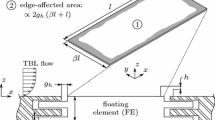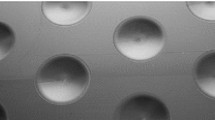Abstract
Motivated by the study of drag on plant canopies, a novel non-intrusive drag measurement device was developed—its design, calibration, and validation are presented. The device is based on isolating a region of a test facility, a section of the bed of an open channel flume in the present case, from the facility itself. The drag plate, sufficiently large to allow for spatial averaging over multiple elements, is constrained to move on essentially frictionless rails in the direction of flow, and the force applied to the plate by the interaction of objects on the plate with the flow is monitored. In contrast to force balances used in wind tunnels, our design allows for easy mounting of multiple elements on different configurations, it holds large vertical loads with negligible effect to the horizontal forces measured, does not require intrusive frames to hold the elements within the flow, all of its components are externally located at the bottom of the flume, providing immediate access for adjustments, and the mounted load cell is easily interchangeable to increase the measurement dynamic range without system modifications. The measurement of two canonical, well-studied cases is used to validate the drag plate approach: drag induced by a turbulent boundary layer and the drag on a rigid cylinder. A third series of experiments, flow through arrays of rigid cylinders, is presented to show the applicability of the drag plate on more complex flows. The experimental results confirm the drag plate approach to be suitable for the accurate direct measurement of drag on simple and complex arrays of objects, which makes it ideal for studies of vegetated flows, natural rough boundary layers, coastal structures, and urban canopies, just to name a few possibilities.






















Similar content being viewed by others
References
Ackerman J, Hoover T (2001) Measurement of local bed shear stress in streams using a preston-static tube. Limnol Oceanogr 46(8):2080–2087
Barnes M, O’Donoghue T, Alsina J, Baldock T (2009) Direct bed shear stress measurements in bore-driven swash. Coast Eng 56:853–867
Callaghan F, Cooper G, Nikora V, Lamouroux N, Statzner B, Sagnes P, Radford J, Malet E, Biggs B (2007) A submersible device for measuring drag forces on aquatic plants and other organisms. N Z J Mar Freshwat Res 41:119–127
Cowen E, Monismith S (1997) A hybrid digital particle tracking velocimetry technique. Exp Fluids 22:199–211
Dunn C, Lopez F, Garcia M (1996) Mean flow and turbulence in a laboratory channel with simulated vegetation. Technical report, Hydraulic Engineering Series No. 51, UILU-ENG-96-2009
Efron B, Tibshirani R (1993) An introduction to the bootstrap. Chapman & Hall, London
Ergun S (1952) Fluid flow through packed columns. Chem Eng Prog 48(2):89–94
Fathi-Maghadam M, Kouwen N (1997) Nonrigid, nonsubmerged, vegetative roughness on floodplains. J Hydraul Eng 123:51–57
Fernholz H, Janke G, Schober M, Wagner P, Warnack D (1996) New developments and applications of skin friction measuring techniques. Meas Sci Technol 7:1396–1409
Freeman G, Rahmeyer W, Copeland R (2000) Determination of resistance due to shrubs and woody vegetation. Technical report, US Army Corps of Engineers
Ghomeshi M, Mortazavi-Dorcheh S, Falconer R (2007) Amplitude of wave formation by vortex shedding in open channels. J Appl Sci 7(24):3927–3934
Khalak A, Williamson C (1996) Dyanmics of a hydroelastic cylinder with very low mass and damping. J Fluids Struct 10:455–472
King A, Tinoco R, Cowen E (2012) A k-\(\epsilon\) turbulence model based on the scales of vertical shear and stem wakes valid for emergent and submerged vegetated flows. J Fluid Mech 701:1–39
Kline S, McClintock F (1953) Describing uncertainties in single-sample experiments. Mech Eng 75:3–8
Koch D, Ladd A (1997) Moderate reynolds number flows through periodic and random arrays of aligned cylinders. J Fluid Mech 349:31–66
Kundu P, Cohen I (2004) Fluid mechanics. Elsevier, Amsterdam
Lightbody A, Nepf H (2006) Prediction of velocity profiles and longitudinal dispersion in emergent salt marsh vegetation. Limnol Oceanogr 51(1):218–228
Nepf HM (1999) Drag, turbulence and diffusion in flow through emergent vegetation. Water Resour Res 35(2):479–489
Nepf HM, Sullivan JA, Zavistoski RA (1997b) A model for diffusion within emergent vegetation. Limnol Oceanogr 42(8):1735–1745
Pope S (2000) Turbulent flows. Cambridge University Press, Cambridge
Raupach MR, Thom AS (1981) Turbulence in and above plant canopies. Annu Rev Fluid Mech 13:97–129
Sand-Jensen K (2003) Drag and reconfiguration of freshwater macrophytes. Freshw Biol 48:271–283
Schlichting H (1979) Boundary layer theory. McGraw-Hill, New York
Schlichting H, Gersten K (2000) Boundary layer theory, 8th edn. Springer, Berlin
Spalart P (1986) Direct simulation of a turbulent boundary layer up to Re = 1410. NASA TechMemo 89407
Sucker D, Brauer H (1975) Investigation of the flow around transverse cylinders. Heat Mass Transf 8:149–158
Tanino Y, Nepf H (2008a) Laboratory investigation of mean drag in a random array of rigid, emergent cylinders. J Hydraul Eng 134:34–41
Tanino Y, Nepf H (2008b) Lateral dispersion in random cylinder arrays at high reynolds number. J Fluid Mech 600:339–371
Tinoco R (2011) An experimental investigation of drag and the turbulent flow structure in simulated and real aquatic vegetation. PhD thesis, Cornell University
Wereley S, Meinhart C (2001) Second-order accurate particle image velocimetry. Exp Fluids 31:258–268
Wienke J, Oumeraci H (2005) Breaking wave impact force on a vertical and inclined slender pile: theoretical and large-scale model investigations. Coast Eng 52:435–462
Zima L, Ackerman N (2002) Wave generation in open channels by vortex shedding from channel obstructions. J Hydraulic Eng 128(6):596–603
Acknowledgments
The authors gratefully acknowledge the support of the National Science Foundation (CBET-0626164) and the help of Paul Charles, Tim Brock, and John Powers in designing and assembling the drag plate, as well as two anonymous reviewers for their helpful comments to improve the manuscript. Dr. Tinoco wishes to thank the Graduate School at Cornell University and the Consejo Nacional de Ciencia y Tecnología (CONACYT) for supporting his work, as well as IH Cantabria where final editing was performed. Any opinions and comments are those of the authors and do not necessarily reflect the views of the sponsors.
Author information
Authors and Affiliations
Corresponding author
Rights and permissions
About this article
Cite this article
Tinoco, R.O., Cowen, E.A. The direct and indirect measurement of boundary stress and drag on individual and complex arrays of elements. Exp Fluids 54, 1509 (2013). https://doi.org/10.1007/s00348-013-1509-3
Received:
Revised:
Accepted:
Published:
DOI: https://doi.org/10.1007/s00348-013-1509-3




